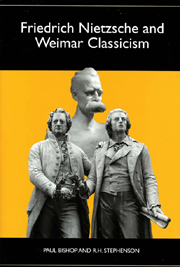Book contents
- Frontmatter
- Contents
- Dedication
- Acknowledgments
- A Note on Editions, Abbreviations, and Translations
- Introduction
- 1 Die Geburt der Tragödie and Weimar Classicism
- 2 The Formative Influence of Weimar Classicism in the Genesis of Zarathustra
- 3 The Aesthetic Gospel of Nietzsche's Zarathustra
- 4 From Leucippus to Cassirer: Toward a Genealogy of “Sincere Semblance”
- Appendix: The Composition of Zarathustra
- Bibliography
- Index
1 - Die Geburt der Tragödie and Weimar Classicism
Published online by Cambridge University Press: 05 February 2013
- Frontmatter
- Contents
- Dedication
- Acknowledgments
- A Note on Editions, Abbreviations, and Translations
- Introduction
- 1 Die Geburt der Tragödie and Weimar Classicism
- 2 The Formative Influence of Weimar Classicism in the Genesis of Zarathustra
- 3 The Aesthetic Gospel of Nietzsche's Zarathustra
- 4 From Leucippus to Cassirer: Toward a Genealogy of “Sincere Semblance”
- Appendix: The Composition of Zarathustra
- Bibliography
- Index
Summary
Was wäre die Welt ohne des Leibes Liebesleben?
[What would the world be without the love-life of the body?]
— Goethe, “Was ist der Himmel, was ist die Welt?”; WA 1.4:164Denn was wäre die Welt ohne Kunst?
[For what would the world be without art?]
— Goethe, Tag-und Jahreshefte 1805; WA 1.35:198IN HIS “VERSUCH EINER SELBSTKRITIK” (“Attempt at a Self-Criticism,” 1886), written fifteen years after Die Geburt der Tragödie (The Birth of Tragedy) was conceived with the thunder of the Battle of Wörth in the background (§1; KSA 1:11), Nietzsche highlighted — but recognized as problematic — the phrase which, in all, occurred three times in his book, namely, “dass nur als ästhetisches Phänomen das Dasein der Welt gerechtfertigt ist” (Versuch §5; KSA 1:17; “that the existence of the world is justified only as an aesthetic phenomenon”; compare GT §5 and §24; KSA 1:47 and 152). Nietzsche explained the phrase as follows in a passage containing two important words, Augenblick and Schein, which point to two key themes of Die Geburt der Tragödie derived from Goethe and Schiller:
Die Welt, in jedem Augenblicke die erreichte Erlösung Gottes, als die ewig wechselnde, ewig neue Vision des Leidendsten, Gegensätzlichsten, Widerspruchreichsten, der nur im Scheine sich zu erlösen weiss […]. (GT Versuch §5; KSA 1:17)
[The world — at every moment the attained salvation of God, as the eternally changing, eternally new vision of the most deeply suffering, conflicted, and contradictory being, who can find salvation only in semblance …]
- Type
- Chapter
- Information
- Friedrich Nietzsche and Weimar Classicism , pp. 24 - 62Publisher: Boydell & BrewerPrint publication year: 2004

